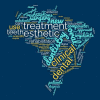Prevalence of lectures about dental esthetics and female speakers in three Brazilian conferences
- PMID: 37466517
- PMCID: PMC10355261
- DOI: 10.1590/0103-6440202305349
Prevalence of lectures about dental esthetics and female speakers in three Brazilian conferences
Abstract
This study analyzed the prevalence of lectures involving esthetics in the scientific program of Brazilian dental conferences and the gender distribution of speakers. All lectures presented in three dental conferences (Bahia, São Paulo, and Goiás states) held from 2016 to 2020 were evaluated. Three investigators individually divided the lectures according to the specialties recognized by the Brazilian Federal Council of Dentistry (FCD) based on their titles. The lectures were also classified as involving or not esthetics, and the speaker`s gender was recorded. Descriptive statistical analyses were performed, and Chi-square tests assessed possible associations between factors. The words most cited in the titles of the lectures were "esthetic" (13.6%), "dentistry" (9.9%), and "treatment" (8.1%). Oral diseases were barely mentioned in the titles (up to 1.3%). The highest number of lectures was observed for the specialty of Restorative Dentistry (22.3%), followed by Prosthodontics (18.5%). Approximately one-third of lectures involved some aesthetic aspect, but this percentage ranged from 71.9 to 78.6% for the two specialties with more lectures. Regarding the speaker`s gender, the inequity was higher for lectures involving esthetics (81.6% of males) than for topics unrelated to esthetics (66.7%). More male speakers than females were observed for all specialties. The highest gender gap was observed for Pediatric Dentistry with 62.4% male speakers, although only 10.6% of FCD registered specialists were men. In conclusion, the Brazilian dental conferences analyzed seemed to favor offering lectures dealing with esthetic topics and male speakers.
Este estudo analisou a prevalência de palestras envolvendo estética na programação científica de congressos de Odontologia brasileiros, e a distribuição do gênero dos palestrantes. Todas as palestras apresentadas em três congressos de Odontologia (CIOBA, CIOGO, and CIOSP) entre 2016 e 2020 foram avaliadas. Três avaliadores utilizaram os títulos das palestras para dividi-las entre as especialidades reconhecidas pelo Conselho Federal de Odontologia (CFO) do Brasil. As palestras foram também classificadas como envolvendo ou não estética, e o gênero do palestrante foi registrado. Análises estatísticas descritivas foram realizadas, e testes de Qui-quadrado avaliaram possíveis interações entre fatores. A palavra mais citada nos títulos das palestras foi “estética” (13,6%), seguido por “odontologia” (9,9%) e “tratamento” (8,1%). Doenças orais foram raramente mencionadas nos títulos (até 1,3%). O maior número de palestras foi observado para a especialidade de Dentística (22,3%), seguido por Prótese Dental (18,3%). Aproximadamente um terço das palestras envolviam algum aspecto estético, com porcentagens entre 71,9 a 78,6% para as duas especialidades com mais palestras. Em relação ao gênero do palestrante, a inequidade foi maior para palestras envolvendo estética (81,6% de homens) que para tópicos não relacionadas à estética (66,7%). Mais palestrantes do sexo masculino que feminino foram observados para todas as especialidades. A maior discrepância entre os gêneros foi observada para Odontopediatria, uma especialidade com 62,4% dos palestrantes do sexo masculino, embora apenas 10,6% dos especialistas registrados no CFO eram homens. Como conclusão, os congressos de Odontologia Brasileiros parecem preferir palestras abordando tópicos de estética e palestrantes do sexo masculino.
Figures


References
-
- Conselho Federal de Odontologia - FCD . Profissionais e entidades cadastradas. Brasília, DF: Conselho Federal de Odontologia; 2022. [November 8, 2022]. Available at: Available at: https://website.FCD.org.br/estatisticas . Accessed.
-
- San Martin A, Chisini L, Martelli S, Sartori L, Ramos E, Demarco F. Distribution of dental schools and dentists in Brazil: an overview of the labor market. Revista da Abeno. 2018;18:63–73.
-
- Morita MC, Uriarte M, Neto, Fontanella VRC, Haddad AE. The unplanned and unequal expansion of Dentistry courses in Brazil from 1856 to 2020. Braz Oral Res. 2020;35 e009. - PubMed
-
- Dental Council of India. New Delhi: 2022. [November 8, 2022]. Available at: Available at: https://dciindia.gov.in . Accessed.
-
- China's University and College Admission System Beijing. 2022. [November 8, 2022]. Available at: Available at: https://www.cucas.cn . Accessed.
MeSH terms
LinkOut - more resources
Full Text Sources
Miscellaneous

